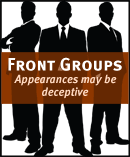Smokepeace
| This article is a stub. You can help by expanding it. |
|
This article is part of the Tobacco portal on Sourcewatch funded from 2006 - 2009 by the American Legacy Foundation. |
|
This article is part of the Center for Media & Democracy's spotlight on front groups and corporate spin. |
Smokepeace was a tobacco industry-supported smokers rights group in northern Europe. It was based in Sweden and used by the industry as a grassroots front group to support industry positions to the public and in legislatures. Smokepeace was part of a broad strategy devised by Philip Morris and Burson Marsteller to create a network of European smokers rights groups to lobby for industry positions. PM exported the smokers rights group strategy from the United States.
History and origin
A 1994 document reveals Philip Morris (PM) as the organizing force behind a supposedly spontaneous global "smokers rights movement," and shows that the British tobacco industry sought to emulate the tactic of organizing smokers rights groups (SRGs), a strategy first employed by PM in the United States to fight public health progress in reducing secondhand smoke exposure, taxes and other issues. The document was written by A.D.C. 'Clive' Turner of the UK Tobacco Advisory Council.
Turner relates how Philip Morris Corporate Affairs executive Ellen Merlo presented the company's strategy of organizing smokers' rights groups to European tobacco companies. The presentation was made to the Public Smoking Working Group of the International Committee on Smoking Issues or ICOSI, the global industry's group created to counter the declining social acceptability of smoking. The paper shows that Philip Morris exported the strategy of organizing smokers rights groups to foreign tobacco companies and mentions the tremendous expense the company had put into this strategy in the U.S.
Turner says,
Ms. Ellen Merlo [Senior VP of Corporate Affairs] from Philip Morris USA came to give the public smoking working group a presentation, and promised to keep us in touch with how the club progressed as the year goes on. The U.S. industry is spending some $10 million on the project; has recruited about 300,000 members so far, and is on course to reach a million by this year's end. Membership dues are $10, but even so, it is not expected that the club will ever be totally self-supporting...
Turner indicated the desire within the UK tobacco industry to emulate this strategy and form such a "national smokers' club," as long as its existence could not be readily tied to the tobacco industry:
"There is an appetite within the industry for a national smokers' club, or alliance, or association, in the UK, providing it operates at arm's length..."
Turner proposed a budget to form such a group in the UK ("not less than ?600,000 in the first year") and suggested that names used for such groups in the U.S. like "Rights Group" and "Club" may not be appropriate in the UK, "having either too strident a connotation, or too elitist, or too political a feel." Turner proposed the name "Smokepeace UK," saying it has a "friendly, quite evocative tone." A handwritten note on the side of the document, (author unknown) frets over the perceived weakness of the proposed name, saying, "Will 'Smokepeace' rally the troops [to] write letters and take action?"
The objectives of forming the group include to "successfully counter threats of tax increases and smoking bans."[1]
References
- ↑ A Strategic Plan for the Issue of Smoking the the Workplace and Public Places Report/presentation, Turner ADC. July 7, 1994. Philip Morris Bates No. 2501358202/8212
<tdo>resource_id=27348 resource_code=smokepeace search_term=Smokepeace</tdo>

